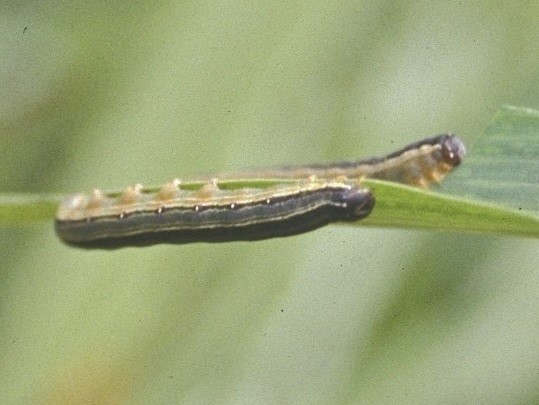PUNE – The fall armyworm (FAW) has invaded India. This is a cause for concern because all species of armyworms can rapidly multiply and are capable of destroying more than 100 species of plants over wide geographic areas. The pest is considered a threat to global food security.
 Its first appearance in India was noted in May 2018 in Karnataka. Its presence has since been confirmed in Tamil Nadu, Telangana, Andhra Pradesh, and West Bengal. In addition, agronomists have detected it feasting on maize and sugarcane in Maharashtra. Its presence has prompted a nationwide pest alert.
Its first appearance in India was noted in May 2018 in Karnataka. Its presence has since been confirmed in Tamil Nadu, Telangana, Andhra Pradesh, and West Bengal. In addition, agronomists have detected it feasting on maize and sugarcane in Maharashtra. Its presence has prompted a nationwide pest alert.
The damage that can be wrought by the fall armyworm is astounding. B.M. Prasanna, the Director of the Global Maize Program at the International Maize and Wheat Improvement Center (CIMMYT), describes the worm as “one of the most destructive crop pests.”
So, why haven’t we heard about the fall armyworm before? There are several reasons. The worm is native to tropical regions of South and Central America. It cannot survive freezing cold weather, so penetration into North America has been limited.
India has not had to deal with the fall armyworm because there are two oceans and the entire continent of Africa between the nearest points of South Africa and India. That is a distance of 7,500 miles. A single FAW in the moth stage of its lifecycle can migrate as far as 300 miles. Its life cycle ranges from 30 to 90 days. An army can destroy an acre of crops in a week or less.
So, how did the fall armyworm make its way to India?
Scientists believe that it has managed to migrate from Africa where it first appeared in Nigeria in 2016. It is believed that the insect made its journey from the Americas to Africa as a stowaway in cargo containers.
The Indian Council of Agricultural Research expects that “With the liberalization of trade, the movement of foodstuffs has considerably increased and this raises the possibility of pests being carried to new destinations, even across oceans.”
The FAW has now made 44 sub-Saharan nations its new home, covering an area of more than 8.5 million square miles – the size of the United States, Australia, and the entire European Union combined.
Mozambique lost nearly 60% of its crop of maize last year with damages estimated at more than $13 billion.
The fall armyworms’ favorite foods include maize, millet, sorghum, sugarcane, rice, and wheat, while it is also capable of feasting on cowpea, groundnut, potato, soybean, and cotton. All of these are important cash crops in India.
According to the Government of India’s Agricultural Statistical Year Book 2017’s records of land usage in India, those crops and other favorites of the FAW occupy 82% of India’s farmland.
The fall armyworm has no natural predators in India, so officials are searching for the best ways to eliminate the pests without doing additional harm to individuals or the environment. Elimination must be by eradication, lest the worms continue their mass migration across the Asian continent.
Global experts and more than 250 officials from across Asia are scheduled to convene at a conference in Ludhiana, India from October 8th-10th to discuss how to preserve the maize crops and prevent the spread of the fall armyworm.
The damage done by the FAW could further endanger millions of Indian people in remote villages who may already be suffering from a lack of food and malnutrition. Please pray for Gospel for Asia’s field partners and other NGOs as they continue to help provide for the needs of many of these people.
To read more news on India on Missions Box, go here
Sources:
- Fresh Plaza, Fall armyworm now found in India
- Business Standard, A migrant from Americas is latest threat to Indian, Asian food security
- International Maize and Wheat Improvement Center (CIMMYT), Fall armyworm reported in India: battle against the pest extends now to Asia
- India Spend, New Migrant To India Could Threaten National (And Asian) Food Security
- Economic Times, Fall Armyworm spreads to five states in India
- India Spend, New Migrant To India Could Threaten National (And Asian) Food Security
Image Source:
- By ChriKo [CC BY-SA 4.0], from Wikimedia Commons
Video Source:
- YouTube, produced by the Times of India




